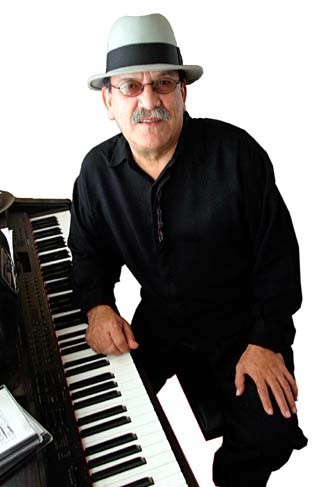The West Side Sound celebrates 17 years as an offshoot of the Southwest's greatest horn section
When you really break it down, there are three great rhythm-and-blues horn sections in America. Which you prefer probably depends on your regional bias. Along the West Coast, there is the Tower of Power. In the mid-South, there is the Memphis Horns. And in the Southwest, we have the legendary West Side Horns.
Over three decades of working with everyone from Doug Sahm to Joe "King" Carrasco to the Band's Rick Danko, the West Side Horns
| Arturo "Sauce" Gonzalez, keyboardist and leader of the West Side Sound pictured at his home in the Five Palms neighborhood. Photo by J. Michael Short. |
Gonzalez' idea was to take the bluesy core of the band, and strip it down from four or five horns to one or two. He dubbed this new band the West Side Sound. This week, Gonzalez celebrates the 17th anniversary of this band with a blowout gig at Blanco Ballroom, featuring such musical friends as Joe Jama, Charlie and the Cool Cats, Sonny Ace, and Little Randy Garibay. Proof of the West Side Sound's local drawing power comes from the fact that their anniversary gigs keep moving to bigger venues. "Two years ago, we jammed at the Lucky Club, but it was too small," Gonzalez says. "Then `we` went to Sam's Burger Joint, and that was too small. Hopefully, this one will be big enough."
Gonzalez can best be described as South Texas' answer to Booker T. Jones. Like Jones, his instrument of choice is the Hammond B3 organ, the very definition of suave soulfulness (Booker T. and the MGs' classic "Green Onions" is one of Gonzalez' favorite club workouts). Even more than Jones, though, Gonzalez has demonstrated an ability to handle a wide range of musical assignments, veering from rock 'n' roll to Tejano to soul to blues.
A native of Roma - "a little town with a thing about Cadillacs, and 90 percent unemployment" - he learned to play by osmosis, hearing his father bang out polkas on the accordion and piano. In 1960, at age 16, Gonzalez enlisted in the Army, falsely claiming to be 17, "because I just wanted to get out of town." While stationed in Northern California
| SAUCE GONZALEZ AND THE WEST SIDE SOUND 8pm Friday May 30 $5 presale $8 door Blanco Ballroom 3719 Blanco Road 732-3510 |
"When I met Bobby, I'd mess around on the piano playing 'Blueberry Hill' and old Little Richard stuff," Gonzalez says.
"He heard me playing and asked me if I wanted to play a gig with him in Santa Cruz. I said, 'I don't know too much.' And he said, 'What you're playing there is good enough.' I was just playing two-finger keyboards, just learning."
Upon returning to San Antonio, Gonzalez played with a string of rock 'n' roll bands before local icon Sonny Ozuna asked him to join his group, the Sunglows, in the summer of 1961. "All the time I had an impression that he was a white dude, 'cause of the way he sang and everything," Gonzalez says. They immediately went into the studio to cut Gonzalez' "Golly Gee" - "It was the first time I'd ever recorded in my life" - and followed it up with a cover of Little Willie John's "Talk to Me," a massive pop hit that landed the Sunglows on American Bandstand. (Gonzalez remembers that Wayne Newton and Gene Pitney appeared on the same show).
When Ozuna left the Sunglows and moved to Houston to start a new band, Gonzalez followed him. During this period, Gonzalez' love of blues and jazz was fueled by the great records he perpetually heard on a Houston club jukebox. He particularly fell for the cool, laid-back elegance of organ virtuosos Jimmy Smith and Jimmy McGriff.
After a late-'60s stint with Tejano legend Little Joe, Gonzalez formed a band called the Mexican Revolution, which
"I'd known Doug since the early '60s," he recalls. "We used to have record hops at Municipal Auditorium, where they'd have 20 or 30 bands in one day, from noon to midnight. Doug used to play there, playing early rock 'n' roll like 'Crazy Crazy Baby.' He was great. He was like a Chicano dude. He had the soul for it 'cause he grew up on the East Side."
These days, Gonzalez can indulge his passion for the blues with the West Side Sound, and still gets to play the occasional gig with its expanded incarnation, the West Side Horns.
"It's a new experience every time," he says of the band. "They all play differently, and they keep you on the edge." •

















